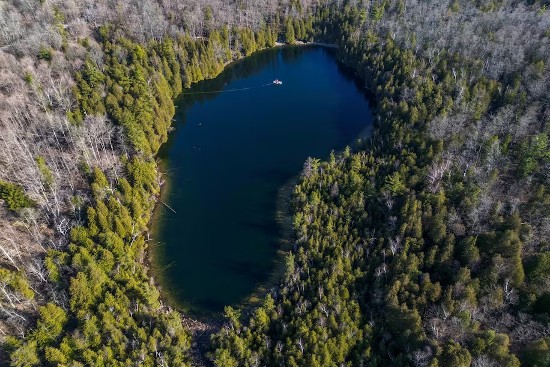Canada made the news last week not just for the wildfires that continue to rage across a number of provinces, but also because of a little-known post-glacial lake just to the northwest of where my wife and I live. The place is called Crawford Lake. It is the principal feature of a conservation area that goes by the same name. And earth scientists studying its lake-bottom sediments called varves believe they provide the quintessential evidence of our geological footprint on the planet and the beginning of the Anthropocene Epoch.
The Anthropocene is a recent term that has been added to the geological record. It is an addendum to the Holocene which stretches back 10,000 years to the first appearance of organized human settlements and the beginning of the agricultural revolution. Anthropocene means the Age of Man. Not all earth scientists and geologists buy into the idea that the period defining the Anthropocene should be separate from the Holocene.
That’s where Crawford Lake’s varves come in. If you are not familiar with varves, they resemble tree rings producing a seasonal pattern in lake deposits. Each varve marks a deposition and a passage of time. And the varves at Crawford Lake are well preserved for study, showing what earth scientists call the Great Acceleration, a period that marks our human environmental impact beginning in the 20th century.
The area surrounding Crawford Lake was inhabited by indigenous people more than 600 years ago. There is evidence that suggests an agrarian settlement at that time. The planting of corn produced corn pollen grains which are evident in the varves. Later varve deposits see the disappearance of corn pollen indicating the site was abandoned a few decades after Europeans arrived in the Americas. Likely, European-introduced diseases wiped out most of the native population.
The annual cycle of varve deposits continued marking the passage of time. And by the early 1950s, something significant showed up. Earth scientists call it plutonium fallout signal from radioactive pollutants appearing in the lake sediments caused by fallout from the atmospheric testing of atomic bombs on Pacific island atolls occurring between 1950 and 1963. The varves contain radioactive traces and, state the earth scientists, mark the beginning of the Anthropocene. The point in time is preserved in the varves of Crawford Lake and has led to this small post-glacial lake being voted “the most suitable location of the proposed golden spike, a global reference in the Earth’s stratigraphic record indicating the start of a new geological unit of time.”
What makes Crawford Lake exceptional is the relatively undisturbed varve layers, resulting from little mixing of its water layers. States Josh Basseches, Director and CEO of Toronto’s Royal Ontario Museum: “If museum objects are stories, then the Crawford Lake sediment cores are epics — hundreds of years of geological change, written in earth and frozen in time. But they are also, more simply, a poignant reminder of humanity’s profound impact on our planet.”
In an article appearing last week in The Washington Post, it calls Crawford “a humble lake in a Canadian suburb.” The paper was one among many making the Anthropocene a headline story.
But others question the need to create a geological epoch called the Anthropocene. In an article that appeared in The Atlantic in 2019, Peter Brannen called it a vanity project. He noted, “Very little of our handiwork will survive the obliteration of the ages. If 100 million years can easily wear the Himalayas flat, what chance will San Francisco or New York have?”
He called the Anthropocene no more than “an interesting thought experiment” that “serves as a useful catalog of our junk” and stated that it served to “inflate humanity’s legacy on an ever-churning planet that will quickly destroy or conceal forever even our most awesome creations.”
Brannen made the case for a vanity project by comparing our existence to the legacy of the dinosaurs, an epoch that lasted 180 million years, 36,000 times longer than human-recorded history. He pointed out that despite the long geological record, dinosaurs left hardly any evidence of their existence. So much of what has been discovered has come from a few select sites. Yet dinosaurs thrived and evolved over millions of generations.
Brannen’s thought experiment reference is interesting. He wrote, “If, in the final 7,000 years of their reign, dinosaurs became hyperintelligent, built a civilization, started asteroid mining, and did so for centuries before forgetting to carry the one on an orbital calculation, thereby sending that famous valedictory six-mile space rock hurtling senselessly toward the Earth themselves—it would be virtually impossible to tell. All we do know is that an asteroid did hit and that the fossils in the millions of years afterward look very different than in the millions of years prior.” He noted that’s what 180 million years buys you in the fossil record. So maybe the revelation of Anthropocene, the Age of Man, is no more than an ego trip for our species. What do you think?
















